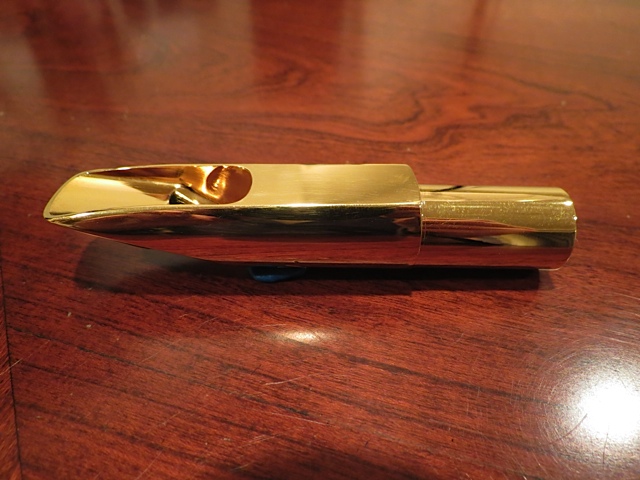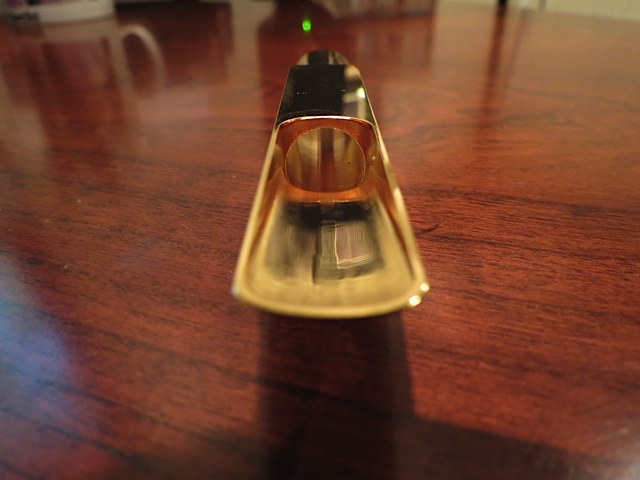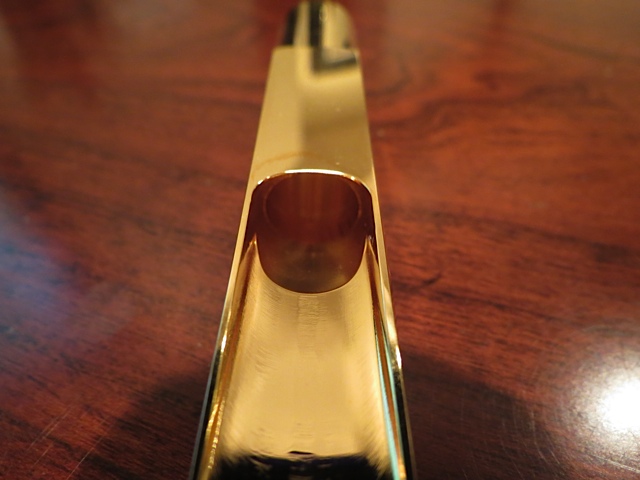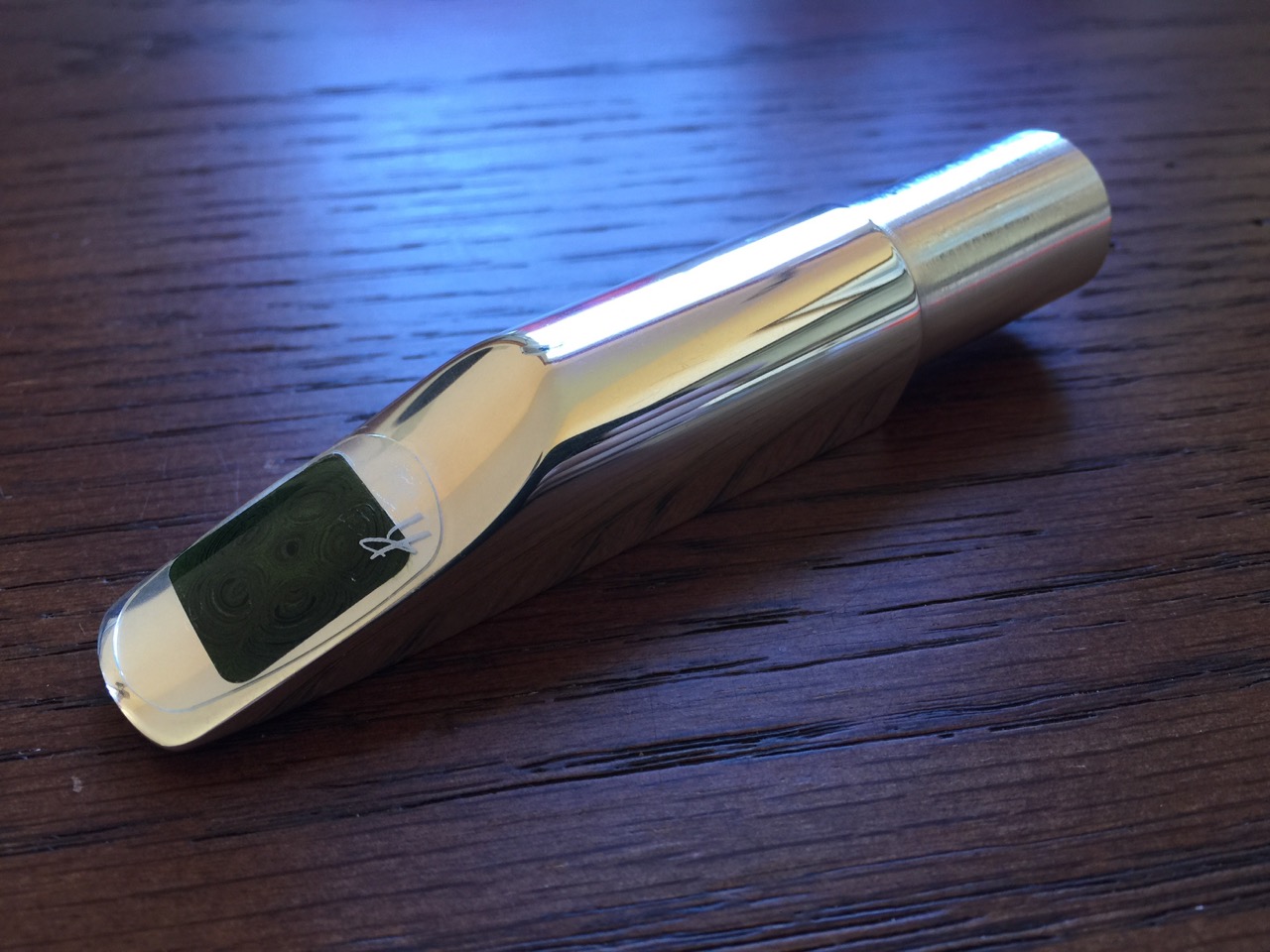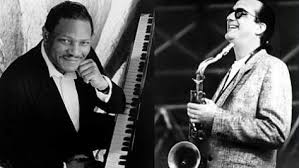I wanted to write a blog post on this subject because there has been a lot of discussion and confusion over the years about the Guardala mouthpiece Michael Brecker played on. I started a discussion on this subject about a month ago on Facebook but thought it would be good to post what I discovered here as well so we don’t have to keep discussing this every 7 months over and over again.
The issue is this: Michael Brecker played a Guardala mouthpiece, no one will argue with this fact, it is well known by fans of Brecker. Sometime in the early 80’s he switched to a Guardala tenor saxophone mouthpiece and he played a Guardala until his death in early 2007. The issue is, what model Guardala mouthpiece did Michael Brecker actually play and what did the inside of his mouthpiece actually look like?
![]()
Original Guardala Tenor Sax Mouthpiece
I was a huge Michael Brecker fan in the 80’s- 90’s. I had every album and CD I could find with Michael Brecker playing on it. I’m sure there are many of you out there that can relate to this. Matter of fact, I think I am mainly a tenor sax player because of Michael Brecker. I played alto saxophone all through high school and college and even though I had heard tons of tenor players during those years I never thought once of switching to the tenor saxophone.
That all changed around 1986 when I first heard Brecker on a recording and then saw him live with Steps Ahead in Buffalo NY. I was obsessed and had to get a tenor saxophone! From the moment I got my first H. Couf tenor sax I was chasing after that elusive Brecker sound and tone. Soon after that I switched to the tenor sax full-time and have been playing it as my main instrument ever since.
Years later, I bought an original Guardala Studio model tenor mouthpiece in search of that Brecker sound. I thought now that I had a hand finished Guardala that my search would be over. Although the Studio model was in that Brecker ballpark as far as sound, I found it extremely bright and too buzzy for me. I found the palm key notes and altissimo thin sounding to my ear. I ended up selling the Guardala studio model a few months later.
A little while later, I heard that WWBW was releasing a Guardala MB mouthpiece. I was ecstatic! Finally, I could try the exact mouthpiece that my idol Michael Brecker played on. I immediately bought one and started playing it. Soon after, I started hearing and reading gossip and rumors that Brecker didn’t actually use the MB model I had just bought. “WHAT!! Is this true?” “What the heck!” “Why release a MB model that wasn’t what Brecker played on?” I was confused, angry and disappointed again.
I tried to find out the truth from a variety of sources on the internet including SOTW and other various chat rooms and forums but it seemed like I could never get a straight answer and every person I talked to had a different opinion and experience to share……..
Then WWBW released the MBII mouthpiece. I heard that this was finally the actual mouthpiece that Michael Brecker actually used. Thank you WWBW!!! Now I could try the mouthpiece that my idol used. I bought one and started playing it. Wouldn’t you know, soon after, I started hearing more rumors and gossip on the internet. “Yeah, the MBII is closer to the Brecker sound but Michael didn’t really play a MBII. His mouthpiece has a smooth baffle with no ledge” “WHAT!!! Come on! Are you kidding me! Why release a MB model that isn’t like Michael’s mouthpiece and then release a MBII that is still not like his mouthpiece? Is this a conspiracy?” Still, I could not get a definitive answer, everyone I talked to had a different take and opinion.
A month ago, I posted a review of the Shizhao Pilgrimage tenor mouthpiece and I asked Mr. Shizhao if this was a copy or an original design. He responded that it was a copy of an original Guardala he had bought off of Ebay and forwarded the description to me from the Ebay ad which again brought up this whole subject of which mouthpiece Michael Brecker actually played:
![]()
Guardala Description from Ebay Ad
Haha!! This ominous posting from an unknown source confirms all the rumors and conspiracies that I have heard! (sarcasm…..) Here is a picture of the Shizhao Pilgrimage model which is a copy of the mouthpiece that was sold in the ad above:
![]()
Liu Shizhoa’s Pilgrimage model exact copy of Guardala Traditional model?
Notice the smooth baffle and lack of a shelf baffle in the photo………..
This is of course proven as fact by an anonymous Ebay seller who heard this truth from the anonymous person that he bought the Guardala from! What more facts do you need! Mystery solved!! (sarcasm…….)
BUT, what of all the people that claim otherwise? Jennifer Price who worked with Guardala wrote this on Facebook:
“Michael mostly used a standard MB1, however for a short period of time he used the MBII which is basically the same with a slightly longer baffle. Both pieces were just regular Guardala pieces. I of course know this because I worked on the pieces he played. Periodically we would go to Mike’s home and he would switch out. He really loved the sound of the wood one we made, it was really hard to make and I’m still picking dust from the wood off me lol but after the three of us discussed it – in the end the wood is not practical, but his smile that day was infectious and to hear him play something that took days to make was definitely a highlight in my life.” -Jennifer Price
“Yes, as I explained we went to Mike’s house a lot and he had a draw of pieces, but……the ones that he played that we made were always the same thing. He would trade out with us each time and kept about 8”-Jennifer Price
So that settles it Michael Brecker played a MBI or MBII which looked similar to this:
![]()
A Vigilante MBI made as Jennifer Price remembers making Brecker’s Guardala
Notice the shelf baffle………..
But then we have these other reported accounts from across the internet:
“When I saw Michael playing in the early 90s, he was actually playing (for that gig anyway) a Branford model.. I had one for a while, and the baffle was smaller/shorter? Meaning a warmer sound..still had a nice refined focus”-John
The original listing Steve posted looks like a misquoted story from Jeff Powell I saw years ago. He said MB decided to use what was called a Traditional model back then. So DG renamed that design the MB and they came up with a new Traditional design that had a lower arched baffle. So if you have a really old Trad, it could be the same as a MB design.-Mojo
What I know was that the so-called MB1 that Brecker played was different from the MB1s sold in the market. The step baffle drop was smooth and not a straight drop. The Traditional model was what Mike played until later when it was renamed the MB1. The MBII was an accident. Somebody in the factory brought home Studio blanks and hand-finished MB1 baffles in them. So the MB2 was actually a bastard-son of the Studio and the MB1.-unknown
I have a friend who was at his master class and saw the inside to his mouthpiece and said it was a roll over baffle no step up at all…-unknown
We originally had two mouthpieces- Studio and Traditional. When Michael decided he would play the Traditional we renamed it Brecker. We then made a new mouthpiece with a slightly shorter baffle and called THAT the Traditional-Jeffrey Powell (also worked with Guardala)
The MBII is actually a Studio, but with a MB chamber/bore. This was how it was created…by accident when one of Dave’s workers brought home Studio blanks and worked the MB chambers into them… I believe Jeff Powell, (Guardala’s partner), said he designed the original MB II for a tour Brecker did with Paul Simon, (as an aside, Jeff also said Michael didn’t use it). From what I remember, Jeff said that he did the CAD/CAM work and Dave finished the pieces, (hand filing them). -Wersax (SOTW)
After reading all these comments, you’re probably even more confused. So am I……. So what is the answer here? What did the inside of Brecker’s mouthpiece actually look like? I’m still confused! Louis Gerrits recently put this picture on Facebook which was cool to see and perhaps helped me come to resolution to this question that has plagued me for years. It is a picture of a cabinet in Michael Brecker’s home. What do you see?
![]()
A Cabinet in Michael Brecker’s Home
If you look down at the bottom of the cabinet in the picture above, you can see what looks like 12-15 Guardala mouthpieces! Is it possible that Michael Brecker had a variety of Guardala models and baffle configurations to choose from? Could it be possible that he at times chose to play on different mouthpieces to suit different gigs? If this is perhaps true, maybe we have an answer to the conflicting reports that I have been reading and hearing over the years.
Maybe the lesson to be learned here isn’t that we need a copy of the exact mouthpiece Michael Brecker played to be great and sound like him but maybe the lesson here is that Brecker perhaps played on different Guardala mouthpieces and baffles throughout his career and if he did, did any of us notice? Or did he pretty much just sound like the amazing Michael Brecker that he always has? Who knows the answer to that one???
At this point you’re probably wanting more definitive answers and proof. Both of which I do not have at this point in time. All I have heard and read is posted above for you to draw your own conclusions. I am still very curious and wish Michael was still around to ask first hand that is for sure.
The purpose of this post wasn’t to so much reveal the definitive answer to this question as it is to raise the question and perhaps get some more insight from readers of this blog. If you have any more inside information on this subject I would love to hear it. Feel free to post in the comments below. Thanks, Steve


